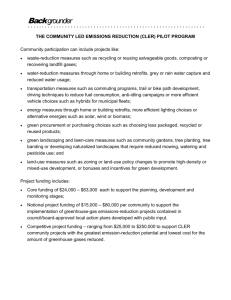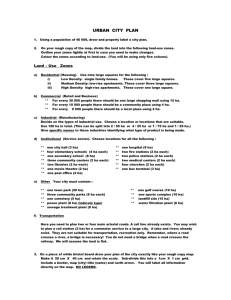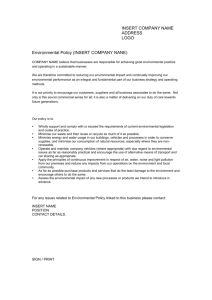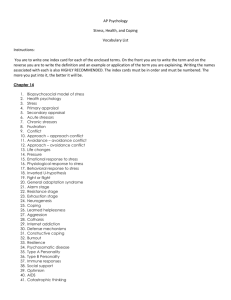Impact avoidance and reduction options template Building capacity of vulnerable groups
advertisement
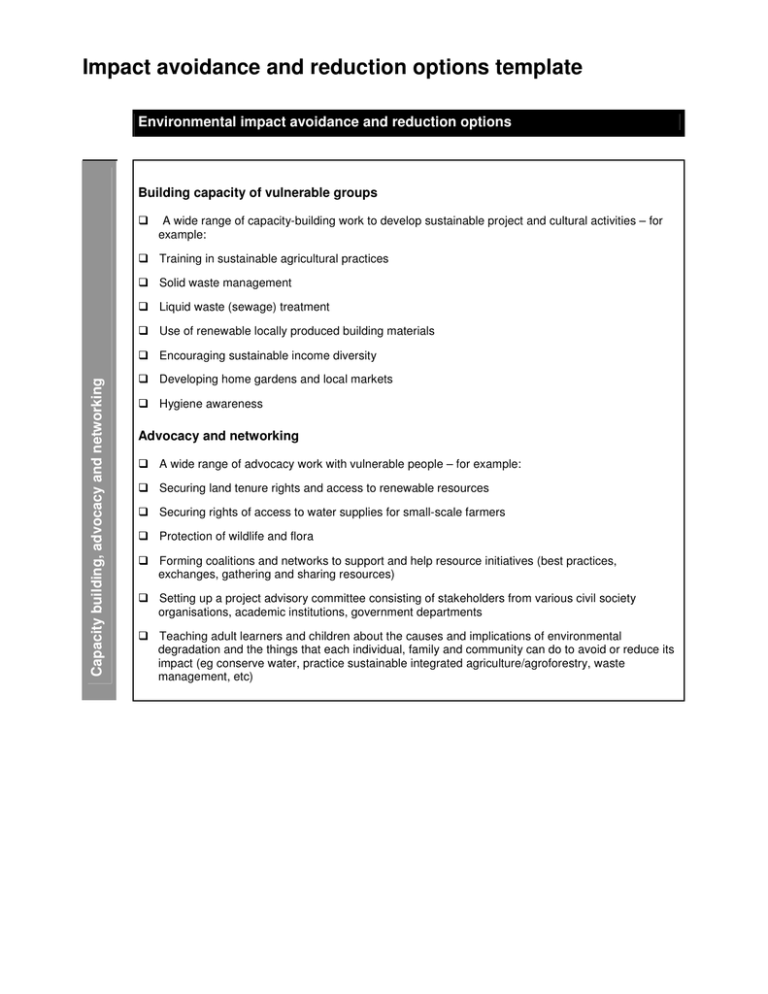
Impact avoidance and reduction options template Environmental impact avoidance and reduction options Building capacity of vulnerable groups A wide range of capacity-building work to develop sustainable project and cultural activities – for example: Training in sustainable agricultural practices Solid waste management Liquid waste (sewage) treatment Use of renewable locally produced building materials Capacity building, advocacy and networking Encouraging sustainable income diversity Developing home gardens and local markets Hygiene awareness Advocacy and networking A wide range of advocacy work with vulnerable people – for example: Securing land tenure rights and access to renewable resources Securing rights of access to water supplies for small-scale farmers Protection of wildlife and flora Forming coalitions and networks to support and help resource initiatives (best practices, exchanges, gathering and sharing resources) Setting up a project advisory committee consisting of stakeholders from various civil society organisations, academic institutions, government departments Teaching adult learners and children about the causes and implications of environmental degradation and the things that each individual, family and community can do to avoid or reduce its impact (eg conserve water, practice sustainable integrated agriculture/agroforestry, waste management, etc) Environmental impact avoidance and reduction options Capacity building Land tenure rights advocacy Demonstrate year-round homestead vegetable gardening Involve children and young people in community discussions related to impact avoidance or reduction activities such as planting trees and introducing new agroforestry techniques Support the diversification of income-generating measures Sustainable natural resource management Encourage the use of sustainable agriculture techniques to improve food security during dry periods Build strength of local organisations to reverse environmental degradation: building capacity within community to manage activities and finance Maximise biodiversity, soil fertility and appropriate land use Crop rotation to maintain soil quality, minimise erosion (reducing the risk of desertification) and plant less water-dependent crops in drier years (rotate legumes and other crops) Training in soil care: protection of natural features, watercourses, trees; avoiding ‘slash and burn’ practices Community forest management and reforestation Crop diversification and crop mixing; mix of crops and trees in agroforestry systems to spread risk and increase biodiversity; animals can also be integrated into these systems, allowing effective recycling of manure and providing a valuable source of protein Use ‘closed loop’ agricultural technique, to maximise crop use and soil quality at all stages Food security Protecting and improving fish stock Encourage communities to conserve coastal mangroves and other vegetation to reduce rate of erosion and protect fish breeding grounds Look at options for sustainable aquaculture such as fish farming in ponds using crop by-products for feed and integrated livestock-fish farming to improve the supply of protein-rich food in the area Advocacy to reduce or relocate coastal dredging, eg for sand or gravel for construction Environmental impact avoidance and reduction options Agrochemicals Avoid or minimise, or use products with low toxicity Training and education programmes on agrochemical safety Establish system for safer handling, cleaning and disposal of containers and equipment Provide education and extension advice on use of agrochemicals Limit use to very specific agricultural needs Use Integrated Pest Management approaches Provide education and advice on natural organic pest control Seeds, tools and fertilisers Use local seeds where possible, procured and distributed through existing channels Limit introduction of non-local seeds to varieties tested locally and known to local users Avoid introduction of genetically modified seed varieties not already in use in the country Provide environmental education on use of tools and develop resource extraction plan which avoids negative environmental impacts where appropriate Education and extension advice on fertiliser use. Limit use to very specific agricultural needs Harvesting wild plants/fruits Establish harvest system based on a balance between rates of extraction and regeneration Expansion of area or type of cultivation Implement land-use plans, taking into account habitat diversity and sustainability of land-use systems Food security Reforestation and afforestation programmes Soil conservation activities Expansion of livestock use Implement land-use plan, taking into account habitat diversity and sustainability of land-use systems Establish/expand animal disease monitoring and control system Environmental impact avoidance and reduction options New farming or livestock raising activities Implement land-use plans, taking into account habitat diversity and sustainability of land-use systems Establish/expand animal disease monitoring and control system Institute land conservation activities Cooking Food security Fishing Sustainable fishing methods, eg lines, large-hole nets. Avoid dragnets/trawlers, clear cutting, poisons and explosives Resource harvesting plan which assures adequate supplies for current and future needs Monitor aquatic resource use and undertake education programme for resource users Limit or avoid introduction of new fish varieties and fish production methods Use fuel-efficient stoves and cooking methods Resource management plan for resources needed to cook or support costs of food preparation Consider organising cooking process to reduce air pollution and fuel demand (eg communal kitchens, dining halls) Efficient irrigation Work with communities to develop strategies for water harvesting Minimise water wastage through more efficient techniques (eg drip-feed rather than flood) Irrigation (expanded) Maintain grass waterways – to conserve run-off or drain floods Use techniques such as contour-bunding and check-dams to delay water flow and improve infiltration Treat wastewater for re-use in agriculture Protect and reforest water catchment areas to improve groundwater resources Establish management plan for water use which assures adequate water for current and future needs Change types of crops / cropping systems and water use Establish filtering system Environmental impact avoidance and reduction options NB: ‘Construction’ includes shelter, public buildings, roads and infrastructure Land conservation and protection Develop and follow resource management and land-use management plans Assess vulnerabilities in construction area and change siting or construction methods accordingly Site buildings above flood levels and away from steep slopes that might destabilise during heavy rains Avoid building on or near slopes at risk of mudslides or landslides Change architecture of buildings, eg passive lighting, heating and cooling Establish new building codes Demarcate certain zones as off-limits Construction Roads, paved or other, new and existing Develop and follow land-use plans Limit access to roads Verify road design against flooding/drainage risk assessment Incorporate erosion mitigation measures in road construction activities Environmental impact avoidance and reduction options Fresh water conservation options – general Street drama about community water resource management Government water transfer programmes Advocacy: securing rights of access to water supplies for small-scale farmers Public health / hygiene campaigns on water collection, conservation and non-contamination Integrated Water Resource Management and Water Basin Management Conserve and reduce run-off, eg dykes, re-use grey water Maximise water capture and storage, including rainwater harvesting, eg using rooftops and tanks Fixation points with well point monitoring Train health workers and others to respond appropriately to crises such as drought Establish and maintain water treatment system Design and maintain water supply structure to minimise standing water and vector breeding sites Plan water provision based on anticipated need and use plan for delivery area which allows current and future needs to be met Consider economic incentives to conserve water Water supply Use hazardous chemicals as recommended and limit inappropriate use through education Conserving fresh water quality Protect water sources and communal water points from pollution: Water Safety Plans Desalination systems Monitor groundwater salinity and abstraction. Over-abstraction can cause salinisation Liquid and solid waste Sanitation Land tenure rights advocacy Establish and maintain sites for sanitary and safe waste disposal operating at international standards Limit waste movement through appropriate collection systems meeting accepted best practices Minimise opportunities for disease transmission and vectors Establish and maintain environmental monitoring program covering air, land and water pollution Environmental impact avoidance and reduction options Healthcare and nutrition Protecting and improving health, nutrition and well-being – general Increase preventative and curative healthcare Increase disease surveillance Establish system for safe disposal of all wastes (solid and liquid) Develop a resource management plan for harvesting of local medicinal herbs and plants Awareness-raising among health professionals about the impacts of pollution and other changes in the environment on increased spread of disease Support participatory preventative measures, eg washing hands, reducing open water containers that breed mosquitoes Industry Develop pollution mitigation and abatement plans, incorporating financial incentives where appropriate Develop site-use plans incorporating transport and population support needs based on level of industrial operation Develop plans for supply of services (eg water, education) for expected population in industrial area Develop and implement a sustainable resource-use plan for target industry SMEs Environmental impact review performed for each enterprise supported. A simple checklist may be sufficient if a number of similar types of Small- and Medium-sized Enterprises (SME) are to be supported Waste disposal plans incorporated into enterprise business plan and monitored Hazards and risks of enterprises assessed and mitigation measures identified before support provided Rubble removal Relief supplies Use minimal packaging – biodegradable, multi-use or recyclable where possible Collect packaging as part of distribution programme. Re-use packaging Develop programme of education and facilities for safe disposal of personal hygiene materials Base assistance on needs assessment, including survivor input Avoid inappropriate materials Select assistance based on local social and economic conditions Develop and follow plans to recycle rubble and dispose of unusable materials in ways which minimise negative environmental impact Some rubble, such as asbestos sheets, is hazardous to humans and the environment and will require special handling and disposal methods Look for opportunities to benefit communities – eg involving community in sorting rubble and selling into local construction sector Environmental impact avoidance and reduction options (Re) settlement Land tenure rights advocacy Develop and follow land-use plan in reconstruction and siting of settlements Conduct hazard and risk assessment of existing and new settlement sites and incorporate results into site selection, planning and construction methods Involve community in settlement design to ensure inclusion of all necessary amenities, allow for local customs (eg cooking methods or funeral practices), ensure peace-building between communities etc General options Other Include the poorest, most vulnerable people in planning and in education programmes Conflict sensitivity and/or peace-building work to ensure sustainable resource management Building good governance to ensure environmental protection


